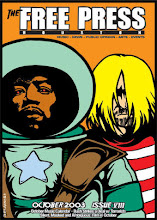Watchmen

I don't know how many hundreds of times I've watched the Zapruder film (hey it's quick) but it was only until Watchmen that I was able to discern the brain parts on the trunk of the ill-fated Ford Lincoln. Watchmen rewrites the history of the 20th century to create its singular alternative cosmology of our bleak existence. Make no mistake, Watchmen dwells in the penthouse apartment of its own gloom.
The action encompasses two generations of super heroes starting around WWII and running up to the mid-80s.
The following is a list (I got it off the internet) of the various characters encountered in Watchmen:
THE WATCHMEN (aka the minutemen):
the comedian (edward blake) b.1918
nite owl (hollis mason) b. 1917
silk spectre (sally jupiter) b. 1918
mothman
silhouette
dollar bill
capt. metropolis
hooded justice
THE NEW WATCHMEN (aka the crimefighters):
the comedian (edward blake)
nite owl 2 (dan dreiberg) b. 1950
silk spectre 2 (laurie juspeczyk) b. 1953
dr. manhattan (jon osterman)
ozymandias (adrian veich) b. 1950
rorschach (walter kovacs) b. 1942
capt. metropolis
The detour point between science fiction and comic strips can be blurry. Watchmen seemed to exist more in the land of sci-fi to these bloodshot eyes than to the pages of comic books. However Watchmen does owe its source to the Alan Moore written graphic novel. Moore, as is widely known, distances himself from movie adaptations of his works. Perhaps a good idea when you consider League of Extraordinary Gentlemen but I had no problem with V For Vendetta. For more on Moore see the documentary The Mindscape of Alan Moore (highly recommended).
Watchmen director Zack Snyder may not overwhelm you with his political point of view but this isn't the Wachowski Brothers on display. Snyder has made one of the best remakes of a horror film (Dawn of the Dead) that I could stand to watch. The jury's hardly out on 300, but I felt that Spartan tale, while visually delicious, was way sillier than anything in Watchmen. Iron Man and Dark Knight are fine popcorn movies, the latter especially well directed, but one thing that irked me was the PG-13 rating and the general inability to go places that question the status quo. Iron Man particularly avoids issues of arms dealing but Tony Stark manufactures armaments for the government. I get it - it's not a Nicholas Cage movie (Lord of War) that nobody saw, it's a superhero movie that everyone watched.
Watchman does cover such sticky subjects although it's up to individual viewers to decide how much heaviosity the subject's dealt with. Snyder's at the top of his game offering mesmerizing images and indeed appropriating a dim Kubrick-esque vision of humanity. If Watchmen fails to achieve true cult status that would be due to the portrayal of mankind as a blight on the solar system.
Snyder fills his enormous canvas with an endless array of archetypes. The costumed heroes, Viet Nam, political corruption and assassination, the impotence of the superman. The musical accompaniment fits in perfectly by offering tunes that would be cliche in any other setting, yet are fresh and real when used by Snyder as backdrops to montages that capsule sum up main story points: "Sounds of Silence," "Ride of the Valkyries" during the Nam sequence, Dylan's "The Times They Are A-Changing" and "All Along the Watchtower" (Hendrix version), Leonard Cohen's "Hallelujah" and of course "First We Take Manhattan," along with more time correct mid-80s tunes like Philip Glass tunes from Koyaanisqatsi and "99 Luftballoons."
In a nutshell after President Nixon outlaws the Watchmen they try to retire but when someone starts methodically eliminating them the remaining members team up to find the culprit. Dr. Manhattan, the ad hoc group leader and the only one with true super powers, provides the spine of the narrative by blowing off his code of super human coolness and meditating on Mars, hoping that sapiens vanish like an extinguished flame from a candle.
You won't be bored despite the films longer than comic attention span running time. There's enough going on to warrant at least a couple of viewings.











